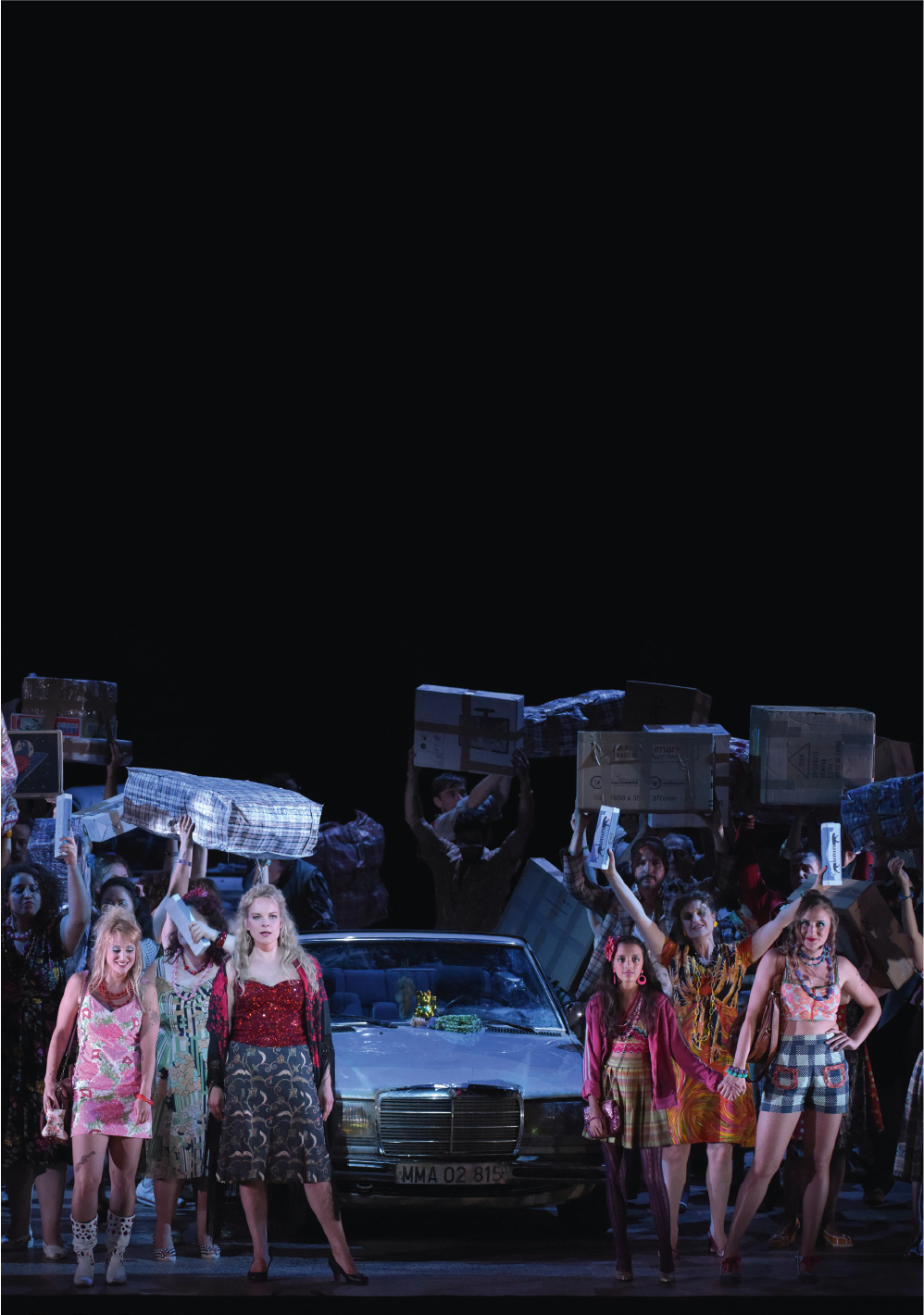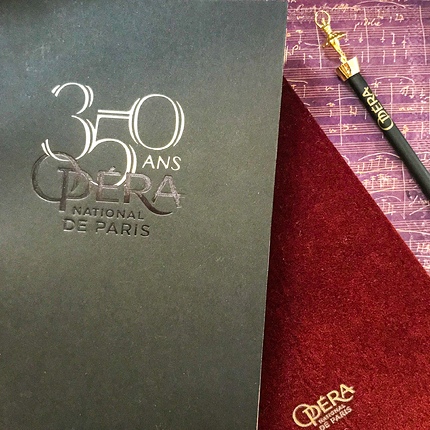At the invitation of Benjamin Millepied, Boris Charmatz is passing on
one of his key works to the dancers of the Paris Opera Ballet: 20 Dancers for the 20th Century.
This “collective exhibition” allows the audience to wander through the public
areas of the Palais Garnier and discover the Company’s dancers in 80 solo
pieces chosen from 20th century works. A delightfully original
occasion.
The first of your works to enter the repertoire of the Paris Opera Ballet, 20 Dancers for the 20thCentury is a multifaceted project. It has known a number of public versions, notably at MoMA in New York and the Tate Modern in London. What were the motivations behind the project?
Boris Charmatz: This project involves memory and history. It invites the dancers and the audience alike to see things from the point of view of studio work and the materials which transform dance into an ingrained practice and thought process. I felt intuitively that this sort of “living choreographic archive” could be adapted to the Corps de Ballet and its repertoire.
During the 20th century, from Marcel Duchamp’s Boîte-en-valise to Marcel Broodthaers’ Museum of Modern Art, Department of Eagles and Martin Kippenberger’s MOMAS, numerous artists have felt a need to question the notion of the “museum”. Each queried the role of the museum-institution in its relationship with society, works of art and the public. In the world of dance, this type of questioning has long been lacking, if not absent. And yet you took up the challenge to combine your work as an artist with running an institution which itself bears the name of “Museum”. In what way does 20 Dancers for the 20th Century fall within the scope of the long-term project you have undertaken?
B.C.: 20 Dancers for the 20th Century is one of the working protocols we invented to bring the Dancing Museum in Rennes to life(1). But we have also produced monographic exhibitions on Jérôme Bel, Xavier Le Roy, Anne Teresa De Keersmaeker, La Ribot—and in the near future—Yvonne Rainer, as well as other themes, such as Krump or Danse-Guerre (Dance-War). We have also produced numerous works conceived by artists for the birth of this new type of museum. We transformed the Tate Modern in London into a Dancing Museum for forty-eight hours(2) with the participation of almost a hundred artists. We took over a public area(3) with a dance designed to evoke a flame kept alive for twelve hours. The performance combined educational elements, transmission, choreography, dancefloor, folklore and contemporary art for the benefit of the crowds who for the most part created the movements for the event themselves. The invention of collective exhibition formats has become a characteristic of the project. The Dancing Museum is a tool devised to structure this necessary desire to bring together things that normally never meet: bodies and thoughts, amateurs and professionals, contemporary art and dance, storyline and improvisation, local and international… It is a project where the majority of the movements are created in Rennes before reaching out and travelling elsewhere. As long as the Dancing Museum helps us to contemplate the contemporary world and its many anxieties, we have to continue this endeavour which has yet to find a suitable permanent building: unless the structures we take over temporarily are ultimately best suited to something reputedly as intangible as the art of dance? Besides, the Dancing Museum works with people from all walks of life: architects, visual artists, amateurs, children, dancers in the widest sense of the term, historians, archivists, and thinkers of all varieties… No doubt, we were destined to work one day with the Corps de Ballet of the Paris Opera. Nevertheless, it’s a strange situation: I trained at the Paris Opera Ballet School, and I’ve been invited there at a time when the generation of dancers to which I belonged are approaching retirement…
What are the artistic principles underlying your 20 Dancers for the 20thCentury project?
B.C.:
It’s a collective exhibition by the Dancing Museum, and intended to be visited
as such: some twenty dancers perform and try their hand at movements taken from
20th century choreography, and visitors can circulate freely as they
encounter some seventy solos and excerpts from ballets. The repertoire
presented in this Paris version is in part drawn from the repertoire of the
dancers themselves and the historic repertoire of the Paris Opera Ballet (which
is not necessarily familiar to them today). We then "grafted" on a
slightly more transversal and transgressive repertoire, taken from previous
editions of the exhibition. Some fifteen artists agreed to lend their
choreographies to the dancers of this project. It is not meant to be an exhaustive
or academic view of 20th century dance, but rather, a sort of
momentary “sampling”, born from the context of our work and the artists who
felt the desire to participate in this adventure. We’ve taken a few short-cuts
and made some improbable cultural leaps: you are just as likely to encounter
choreographic pieces from the pioneers of modern dance as evocations of
performances of the 1970s, then pass without transition from a fragment of
William Forsythe to an improvised voguing session. Our subject is clearly 20
dancers for the 20th century and not 20 choreographers for the 20th
century: it is the dancers who are free to choose the way they perform jazz or
Butoh or dance by Valeska Gert,
Dominique Bagouet and Trisha Brown: the museum flourishes both in and through
their bodies. During previous editions of the project, notably at the Tate
Modern or MoMA or an open-air Second World War memorial in Berlin, the
exhibition could be viewed for five hours and sometimes more. However, for the
Paris Opera, we have reduced the length to 90 minutes—and three hours on
Saturdays. We dance in the public salons and foyers so as to “oddly” revive the
historic interaction that once existed between the subscribers and the dancers.
Above all, it allows us to approach dance without the usual trappings of a
performance at the Opera thus affording us a degree of minimalism and freedom
well-suited to the modern movements we seek to approach.
Jacques Drillon points out that “it is because performers are denied their status as creators that they are denied the right to position themselves in the course of history(4)”. The opus that you are presenting at the Paris Opera this season comes across as a riposte to that situation. It also has its place in a rationale that characterises an entire chapter of European choreographic creation in the last twenty years. Here and there, we have seen the emergence of a myriad of initiatives along these lines which demonstrate the attention given to the history of the works and the role played by the dancers performing them as opposed to just the choreographers alone. You yourself have created a project which, among others is helping to offer a greater visibility to this type of approach: the Dancing Museum that you have directed in Rennes for the last seven years. In what way does 20 Dancers for the 20th Century stem from this wider dynamic?
B.C.: I myself am a dancer for other choreographers and
artists—from Odile Duboc or Meg Stuart to Anne Teresa De Keersmaeker or Tino
Sehgal. And I think that, while fully respecting the strength of the
choreographers, it is possible—thanks to this experience of being a dancer—to
redefine the role of history, memory, invention and politics in the field of
dance. Through the viewpoint of the dancers, the Dancing Museum (which also
gives its name to the annual competition that we have introduced in
coordination with the Théâtre de la Ville in Paris) stands for a wider concept
of dance. We hope to invent a new type of public forum through dance and for
dance. A forum that is neither a school nor a theatre, and we are doing so with
the idea that everyone can experiment with dance, in a wider historical
perspective in which the Viennese Actionists, Charles Chaplin, Vito Acconci and
even Tex Avery all have something to teach us as we invent the movements and
gestures required for today and tomorrow. We are inventing this museum by
conducting a little experimental archaeology and above all, by working with
contemporary artists, including, for example, Vera Mantero and Alain Buffard,
who are also presented in the project at the Opera.
Jean-Christophe Bailly notes that “any attempt to interpret the works of the past comes down to picking apart their fabric again”. He adds that to interpret “is to dissect, it means reforming what has already been formed, it means never listening to an answer, on the contrary, it means reformulating a question, replaying a system of doubt and adventure(5)”. In this regard, how do you work with the dancers of the Paris Opera Ballet, given that their training, career paths and day-to-day working conditions are somewhat different to those with which you have collaborated with until now?
B.C.: First of all, it’s important to make it clear that I did not choose the group of dancers with whom I’m working: They all volunteered for the project because I didn’t want to resort to an audition process as is often the case. Initially, we talked a great deal about what they wanted to dance, but also about what motivated each one of us with regard to the project. We soon started dancing, exchanging dances and working to expand our respective cultural environments: they convinced me to feature Nureyev in the repertoire and also agreed to try to learn some Vera Mantero and Mike Kelley! And it’s a real pleasure working with them, even if it is nothing like working with the artists involved in previous editions of the project: you can’t compare Ko Murobushi tetanising the atmosphere with his age-old learning and a dancer watching a Butoh dance for the first time and then expect to find a close affinity between them… And yet, it is that distance between the solidity of the skills and the techniques developed at the Opera and the fragility of the link with the most astringent modern artistic forms which is at the very heart of this project today.
20 Dancers for the 20th Century will be presented in some of the public areas of the Palais Garnier and not on the theatre’s stage. In particular, this choice implies another form of relationship between the audience and the dancers where physical proximity plays a key role. What priorities motivated that choice?
B.C.: Benjamin Millepied was the first person to see my very first piece which was choreographed with Dimitri Chamblas. Today Dimitri is the artistic director of the Paris Opera’s 3e scène. It was also Benjamin Millepied who took me to visit the Opera—or I should say revisit it—and I absolutely wanted to perform off stage, no doubt because as a child and a native of Savoy, I was fascinated by Charles Garnier’s architecture. The salons allow us to create a “forest” of movements, through which you can wander, glean, learn and feel. The audience’s proximity with the performers allows them to ask a dancer who has just finished dancing a question. They can choose their viewpoint, they can decide to remain with a single dancer to the exclusion of all others because they want to learn more about a particular body that allows itself to move from Isadora Duncan to Balanchine or Nijinska. Once again, it’s a museum: you believe that you are visiting dance, but it is dance which is visiting you. Dance is noisy, it waivers, it works and makes us work… By dancing on the very floor that the audience cross, the entire politics of dance and bodies are transformed.
Benjamin Millepied’s invitation to participate in his first season for the Paris Opera Ballet supposes a slightly different artistic configuration to the projects you usually undertake. What motivations led you to take up his invitation?
B.C.: I had never done a major project for a Ballet. But Benjamin Millepied and Stéphane Lissner have opened the doors to a new era. I’m delighted to participate in this endeavour and I think that the Museum for Dance project is a way to begin working with this House, as a sort of juxtaposition between two contrasting visions of a museum. I don’t know what the result will be... The dancers are preparing for an orgy of movements!
Christophe Wavelet is an art historian, a critic and a trustee. He co-founded the Knust
Quartet (1993-2001) and was a member of the editorial boards for the magazines Vacarme (1998-2001) and Mouvement (1999-2002). As Director of
LiFE – Lieu international des Formes Emergentes (the international forum for
emerging forms) (2005-2010), he taught regularly in different art schools in
Europe and Latin America. A Fellow at the Akademie
Schloss Solitude (2012-2013), he has acted as an arts commissioner since then
at the invitation of the Centre national de la danse in Paris.



































































